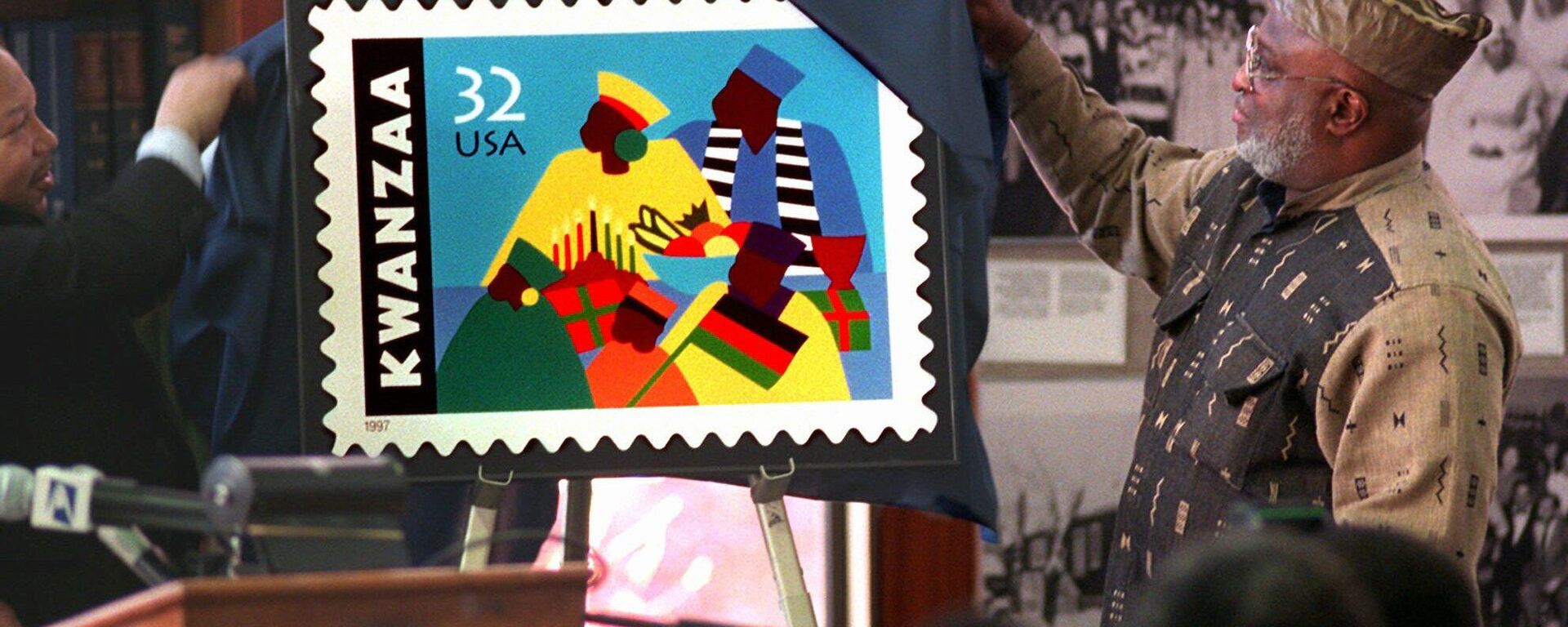https://sputnikglobe.com/20230330/medieval-swahilis-had-african--asian-roots-new-dna-study-reveals-1108946272.html
Medieval Swahilis Had African & Asian Roots, New DNA Study Reveals
Medieval Swahilis Had African & Asian Roots, New DNA Study Reveals
Sputnik International
A new study published in the weekly scientific journal, Nature, revealed that medieval-era Swahili civilization on Africa’s eastern coasts had a mixture of African and Asian genes.
2023-03-30T09:52+0000
2023-03-30T09:52+0000
2023-03-30T09:53+0000
africa
east africa
new study
scientific study
dna
genetics
swahili (kiswahili)
kenya
tanzania
madagascar
https://cdn1.img.sputnikglobe.com/img/07e7/03/1e/1108946783_0:0:3195:1797_1920x0_80_0_0_cb31280d036e6b0367ee9aace182c262.jpg
A new study published in the weekly scientific journal, Nature, revealed that medieval-era Swahili civilization on Africa’s eastern coasts had a mixture of African and Asian genes.Scholars from a number of research institutes in Canada, France, Kenya, Madagascar, Tanzania, United Arab Emirates, the United Kingdom, and the United States, sequenced the DNA of 80 individuals who lived in various Swahili regions from 1250 to 1800 CE.The Asian genetic contribution shifted to Arabian sources after 1500 CE. The study confirms ancient oral histories about the shared ancestry of Swahili people and settles a "longstanding controversy" from colonial times about the contribution of Africans to Swahili civilization, which included the coastal regions of modern-day Kenya, Tanzania, southern Somalia, northern Mozambique, Madagascar, and the Comoros and Zanzibar archipelagoes.The hallmarks of Swahili civilization, the research revealed, predated the arrivals from abroad, and the timeline is consistent with the Kilwa Chronicle which tells of Persians arriving from about 1000 CE when Islam became a dominant religion in the region.Chapurukha Kusimba, a distinguished American anthropologist originally from Kenya and co-supervisor of the study, expressed his excitement about the research, saying that the study was "the highlight of my career."Kusimba, a professor at the University of South Florida, in the United States, and the University of Nairobi, Kenya, who has been working on the origins of the Swahili people for 40 years, explained that colonial-era archaeologists believed that Africans lacked the mental capacity to build medieval Swahili infrastructure and cemeteries, crediting foreign influence instead.The Kenyan-American professor added that the latest study emphasized the "Africanness of the Swahili" while recognizing the Persian and Indian connection. According to David Reich, a Harvard University geneticist and the study's co-supervisor, the DNA evidence reveals that Persian men had children with African women.Kusimba noted that this did not necessarily indicate sexual exploitation, due to the matriarchal nature of Swahili societies. In the meantime, Reich suggested that it was more likely that Persian men allied with and married into local trading families and adopted local customs to become more successful traders.By 1500 CE, the bulk of Swahili Asian ancestry increasingly came from Arabia, the study indicates.It is worth noting that Swahili is the most widely spoken language in the African continent, with a total number of more than 200 million speakers distributed across the region of East Africa, particularly in Tanzania, Kenya, Uganda, Rwanda, Burundi, the Democratic Republic of the Congo (DRC), South Sudan, Somalia, Mozambique, Malawi, Zambia, and Comoros.
https://sputnikglobe.com/20221226/kwanzaa-a-feast-celebrating-african-roots-heritage--culture-1105796497.html
africa
east africa
kenya
tanzania
madagascar
uganda
comoros
ancient persia
Sputnik International
feedback@sputniknews.com
+74956456601
MIA „Rossiya Segodnya“
2023
Muhammad Nooh Osman
https://cdn1.img.sputnikglobe.com/img/07e4/08/0e/1080170965_2:0:2050:2048_100x100_80_0_0_1de8233c87df0979e7e74f61b6ffacad.jpg
Muhammad Nooh Osman
https://cdn1.img.sputnikglobe.com/img/07e4/08/0e/1080170965_2:0:2050:2048_100x100_80_0_0_1de8233c87df0979e7e74f61b6ffacad.jpg
News
en_EN
Sputnik International
feedback@sputniknews.com
+74956456601
MIA „Rossiya Segodnya“
Sputnik International
feedback@sputniknews.com
+74956456601
MIA „Rossiya Segodnya“
Muhammad Nooh Osman
https://cdn1.img.sputnikglobe.com/img/07e4/08/0e/1080170965_2:0:2050:2048_100x100_80_0_0_1de8233c87df0979e7e74f61b6ffacad.jpg
dna analysis african origins, swahili history and culture, african cultural identity, colonialism and african beliefs, historical accuracy in african studies, cultural identity in africa, genetic research on african populations, anthropological approaches to african studies, decolonizing african history and culture, identity politics in africa, swahili, kiswahili, swahili people, swahili ancestry, swahili language, is swahili a mix of arabic? , is it easy to learn swahili? , are swahili and arabic similar? , what country speaks swahili? , medieval swahilis had african & asian roots,
dna analysis african origins, swahili history and culture, african cultural identity, colonialism and african beliefs, historical accuracy in african studies, cultural identity in africa, genetic research on african populations, anthropological approaches to african studies, decolonizing african history and culture, identity politics in africa, swahili, kiswahili, swahili people, swahili ancestry, swahili language, is swahili a mix of arabic? , is it easy to learn swahili? , are swahili and arabic similar? , what country speaks swahili? , medieval swahilis had african & asian roots,
Medieval Swahilis Had African & Asian Roots, New DNA Study Reveals
09:52 GMT 30.03.2023 (Updated: 09:53 GMT 30.03.2023) Muhammad Nooh Osman
Writer/Editor
An international team of scholars from various universities and research institutes, encompassing Canada, France, Kenya, Madagascar, Tanzania, the United Arab Emirates, the UK, and the US, made a discovery confirming ancient narratives about the shared ancestry of the Swahili people from the east African coast.
A new study published in the weekly scientific journal,
Nature, revealed that medieval-era Swahili civilization on Africa’s eastern coasts had a mixture of African and Asian genes.
Scholars from a number of research institutes in Canada, France, Kenya, Madagascar, Tanzania, United Arab Emirates, the United Kingdom, and the United States, sequenced the DNA of 80 individuals who lived in various Swahili regions from 1250 to 1800 CE.
The genetic study showed that approximately half of the DNA was from overwhelmingly male migrants from southwestern Asia, mostly from Persia and India. The other half was almost entirely African women.
The Asian genetic contribution shifted to Arabian sources after 1500 CE. The study confirms ancient oral histories about the shared ancestry of Swahili people and settles a "longstanding controversy"
from colonial times about the contribution of Africans to Swahili civilization, which included the coastal regions of modern-day Kenya, Tanzania, southern Somalia, northern Mozambique, Madagascar, and the Comoros and Zanzibar archipelagoes.
The hallmarks of Swahili civilization, the research revealed, predated the arrivals from abroad, and the timeline is consistent with the Kilwa Chronicle which tells of Persians arriving from about 1000 CE when Islam became a dominant religion in the region.

26 December 2022, 12:01 GMT
Chapurukha Kusimba, a distinguished American anthropologist originally from Kenya and co-supervisor of the study, expressed his excitement about the research, saying that the study was "the highlight of my career."
Kusimba, a professor at the University of South Florida, in the United States, and the University of Nairobi, Kenya, who has been working on the origins of the Swahili people for 40 years, explained that colonial-era archaeologists
believed that Africans lacked the mental capacity to build medieval Swahili infrastructure and cemeteries, crediting foreign influence instead.
However, more recent research has shown that at least 95% of the material recovered from Swahili archaeological sites was "home-grown," including the architecture itself.
The Kenyan-American professor added that the latest study emphasized the "
Africanness of the Swahili" while recognizing the Persian and Indian connection. According to David Reich, a Harvard University geneticist and the study's co-supervisor, the DNA evidence reveals that Persian men had children with African women.
Kusimba noted that this did not necessarily indicate sexual exploitation, due to the matriarchal nature of Swahili societies. In the meantime, Reich suggested that it was more likely that Persian men allied with and married into local trading families and adopted local customs to become more successful traders.
By 1500 CE, the bulk of Swahili Asian ancestry increasingly came from Arabia, the study indicates.
It is worth noting that Swahili is the most widely spoken language in the African continent, with a total number of more than 200 million speakers distributed across the region of East Africa, particularly in Tanzania, Kenya, Uganda, Rwanda, Burundi, the Democratic Republic of the Congo (DRC), South Sudan, Somalia, Mozambique, Malawi, Zambia, and Comoros.




